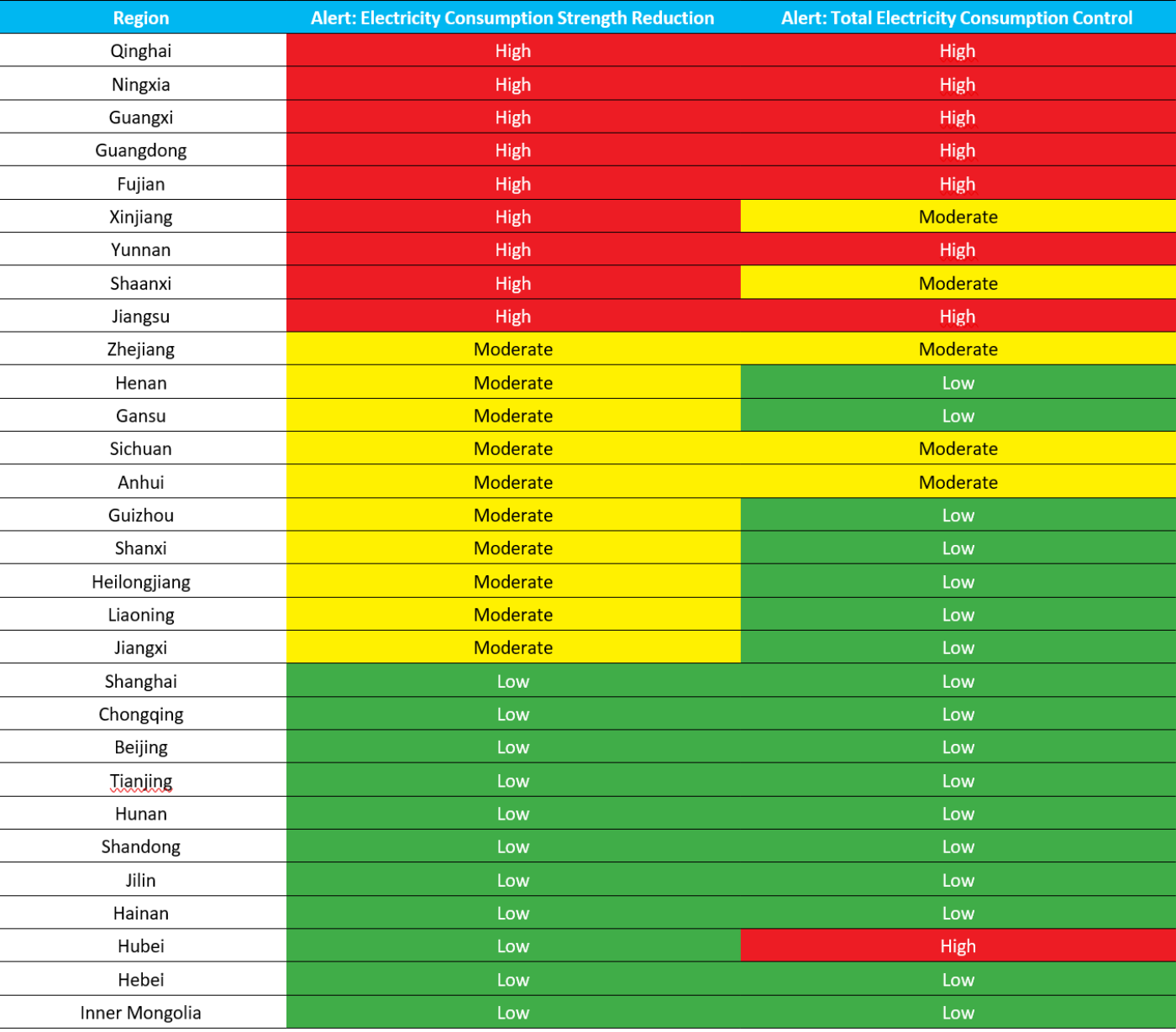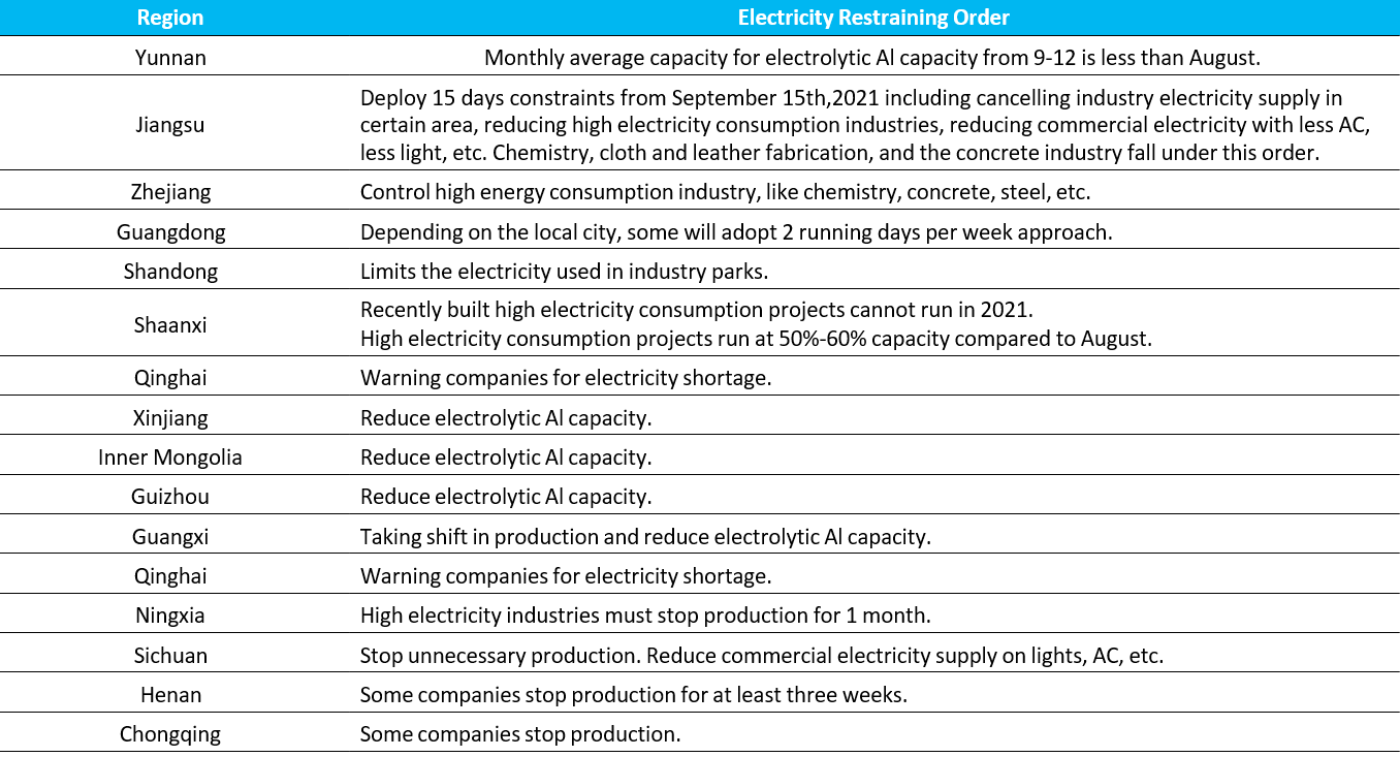国内お問い合わせ窓口
info@displaysupplychain.co.jp
FOR IMMEDIATE RELEASE: 10/04/2021
Electricity Usage Now Restricted in China - Revealing the Impact to Display Industry
Chase Li, Senior Display AnalystChina -
Last week, many provinces and states in China deployed a strict electricity usage policy with a significant impact to the entire country. Many publicly listed companies have had to shut down their plants partially or fully. The constraints in electricity usage not only affect manufacturers, but also extend to electricity for residents in some areas. The electricity constraints are likely to continue for the rest of 2021.
Here is the timeline:
- On August 17th, 2021, the Ministry of Ecology and Environment of PRC released an alert showing that some states had reached their limit for electricity consumption;
- On September 16th, 2021, the Ministry of Ecology and Environment of PRC released a guideline to control electricity consumption;
- Later, many states received a red alert to start deploying restraining orders in electricity usage.
Cloth, fiber and leather fabrication, construction (glass, concrete and steel) and petrochemical refineries are the areas with the most direct impact. Display production plants are not yet affected.
However, many places are expected to extend the electricity constraints to the end of 2021. If the local government cannot reach its consumption standards, it may adopt more extreme measures for high electricity consumption and pollution industries in the coming months. Some indirect impacts may affect the FPD industry.
The first indirect impact may be an increase in the price of metals. The production of fine Al will be reduced; thus, the price of Al is likely to increase for the rest of the year. Al is not the only metal that is influenced by this policy. According to an environmental protection list released in 2018, many other metals used in FPD production are also considered as products with high pollution and electricity consumption. Those metals include Mn, Si, Cr, Ni, Cu, Pd, Mg, Au, etc. If the production of these metals is limited, the price will increase.
2021 Power Consumption Alert in China
Restraining orders up to Sept 23rd, 2021
The price of chemicals will also increase. Because many chemicals used in display production are produced in petrochemical refineries, capacity reduction at these sites will reduce the supply of chemicals.
Some specialty gas prices could increase. For instance, SiH4 and BCl3 are used in FPD production. BCl3 is considered to be a product with high pollution and high electricity consumption. It is the same for SiF4, one of the raw materials to make SiH4. Similarly, PCB prices may be affected since PCBs are listed as products with high pollution and high electricity consumption.
Currently, the electricity constraint order has little influence on FPD production, but the overall Producer Price Index (PPI) is likely to increase for the rest of 2021, and this can hurt margins in many industries. In the meantime, lower production also means a weaker economy, slower GDP growth and a higher unemployment rate in Q4’2021. Since China serves as one of the world’s largest manufacturing centers, the PPI increase will likely affect inflation in other countries.
The energy constraints may affect China’s economy beyond 2021. In prior years, China developed plans to change the manufacturing structure to higher profits and lower energy consumption. In September 2021, the PRC’s Ministry of Ecology and Environment released a document stating that more constraints will be applied to projects with high energy consumption and pollution. Power consumption reductions will be revaluated each year for projects that consume more than 50K tons of coal for energy generation per year, along with pollution controls. This means that in the coming years, all FPD plants in China may face strict rules in production.
For a sense of this scale, the annual electricity usage in IVO alone requires 70K -80K tons of coal without considering the energy loss in transportation. Larger lines with higher capacities will consume more power on an annual basis.
About Counterpoint
https://www.displaysupplychain.co.jp/about
[一般のお客様:本記事の出典調査レポートのお引き合い]
上記「国内お問い合わせ窓口」にて承ります。会社名・部署名・お名前、および対象レポート名またはブログタイトルをお書き添えの上、メール送信をお願い申し上げます。和文概要資料、商品サンプル、国内販売価格を返信させていただきます。
[報道関係者様:本記事の日本語解説&データ入手のご要望]
上記「国内お問い合わせ窓口」にて承ります。媒体名・お名前・ご要望内容、および必要回答日時をお書き添えの上、メール送信をお願い申し上げます。記者様の締切時刻までに、国内アナリストが最大限・迅速にサポートさせていただきます。

